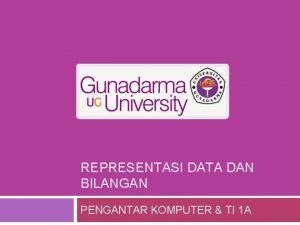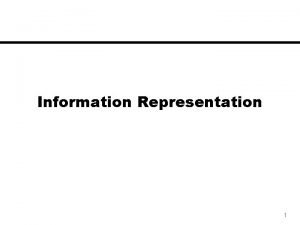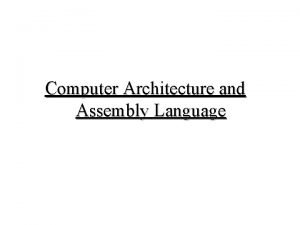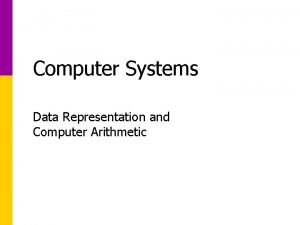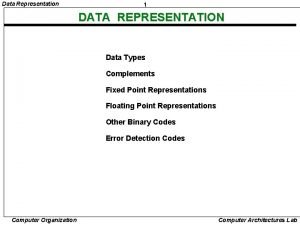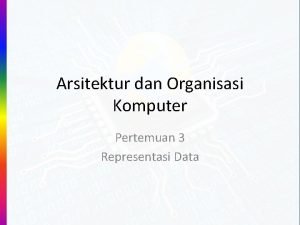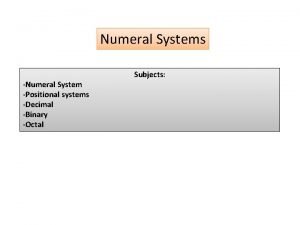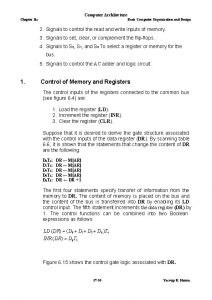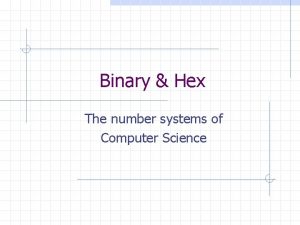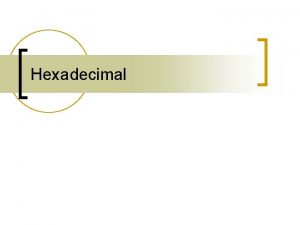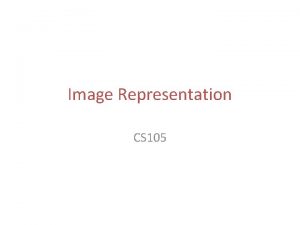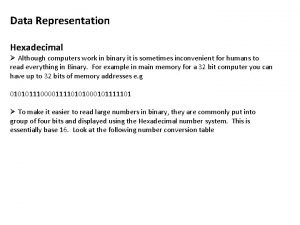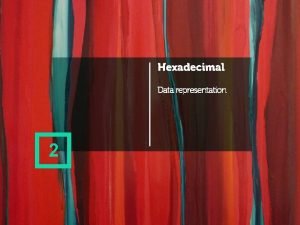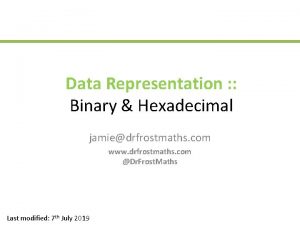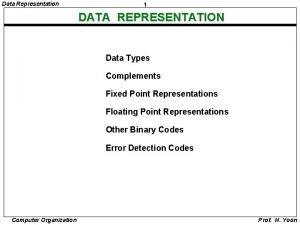Fundamentals of Data Representation Hexadecimal Computer Science Hexadecimal












- Slides: 12

Fundamentals of Data Representation Hexadecimal Computer Science

Hexadecimal • We’ve looked at two number systems Denary (a. k. a. decimal): Base 10 Binary: Base 2 • There all kinds of number systems out there, but there’s one more useful one • Called hexadecimal 2 Fundamentals of Data Representation: Hexadecimal

Hexadecimal • Hexadecimal is a base 16 number system • First, let’s look at the values for a possible digit: 0 -9 then A-F Hexadecimal 0 1 2 3 4 5 6 7 8 9 A B C D E F Denary 0 1 2 3 4 5 6 7 8 9 10 11 12 13 14 15 • There’s a reason why we look at hexadecimal To do with its relation to binary 3 Fundamentals of Data Representation: Hexadecimal

Hexadecimal • Let’s look at the same values – But this time we’ll include the binary values Hexadecimal 0 1 2 3 4 5 6 7 8 9 A B C D E F Denary 0 1 2 3 4 5 6 7 8 9 10 11 12 13 14 15 0001 0010 0011 0100 0101 0110 0111 1000 1001 1010 1011 1100 1101 1110 1111 Binary 0000 • Notice how the denary value 15 fits into 4 binary bits, but 1 hexadecimal digit? 4 Fundamentals of Data Representation: Hexadecimal

Hexadecimal 0 1 2 3 4 5 6 7 8 9 A B C D E F Denary 0 1 2 3 4 5 6 7 8 9 10 11 12 13 14 15 0001 0010 0011 0100 0101 0110 0111 1000 1001 1010 1011 1100 1101 1110 1111 Binary 0000 • This nice ‘coincidence’ makes representing binary easy Instead of using 4 binary digits, we can use 1 hexadecimal digit • It’s worth noting that this easier representation is purely for us Computers will still use binary 5 Fundamentals of Data Representation: Hexadecimal

Converting to Hexadecimal • As we have another number system, we’ll need to know how to convert From denary to hexadecimal From binary to hexadecimal From hexadecimal to denary From hexadecimal to binary • Luckily, the best way to convert between hexadecimal and denary is to go through binary So we only need to work out how to go between hexadecimal and binary Denary 6 Binary Fundamentals of Data Representation: Hexadecimal

Converting to Hexadecimal • Binary and hexadecimal neatly come together in a 1: 4 ratio Converting binary to hexadecimal is easy • We separate the binary number into groups of 4 Adding most-significant zero’s as needed • Then translate each group into a hexadecimal digit • Finally, we write those digits in order 7 Fundamentals of Data Representation: Hexadecimal Example We have: 0110012 (2510) First we make the groups and add 0’s as needed 0001 1001 We get the denary value of each group (and get their hexadecimal value) 00012 = 110 = 116 10012 = 910 = 916 Then we write the digits in order 1916

• Convert the following denary values into hexadecimal 8 28 11 39 150 200 255 Fundamentals of Data Representation: Hexadecimal

Converting from Hexadecimal • Converting from hexadecimal to binary works in the exact opposite way Example • We split the hexadecimal number into its digits First we split the number into its digits (and convert each one into denary) • We find the denary value of each digit • We convert that denary value into a 4 -bit binary number • Finally, we write the binary numbers in order From left-to-right 9 Fundamentals of Data Representation: Hexadecimal We have: A 516 A 16 = 1010 516 = 510 Then we convert each number into 4 -bit binary 1010 = 10102 510 = 01012 Then we write these numbers on after the other 101001012

• Convert the following hexadecimal values into denary 10 F 2 A 1 8 C B 1 CD D 7 Fundamentals of Data Representation: Hexadecimal

Some Uses of Hexadecimal • There are two common uses of hexadecimal Colours Some systems use 1 byte per colour (red, green, and blue) Makes 24 -bits in total Can be shortened to a 6 -digit hexadecimal number Memory Addresses Come in 32 -bit or 64 -bit binary values Can be shortened to 8 - or 16 -digit hexadecimal numbers 11 Fundamentals of Data Representation: Hexadecimal Useful Note In programming languages: 10: a denary value 1010 0 x 10: a hexadecimal value 1610

 Data representation computer science
Data representation computer science Hexadecimal definition computer science
Hexadecimal definition computer science Data representation in computer organization
Data representation in computer organization Binary language
Binary language Data representation and computer arithmetic
Data representation and computer arithmetic Data types in data representation
Data types in data representation Karakter alfanumerik
Karakter alfanumerik Hex code ascii
Hex code ascii Decimal to binary table
Decimal to binary table The content of ac in the basic computer is hexadecimal a937
The content of ac in the basic computer is hexadecimal a937 0111 binary
0111 binary My favorite subject is maths
My favorite subject is maths Forensic science fundamentals and investigations chapter 6
Forensic science fundamentals and investigations chapter 6
